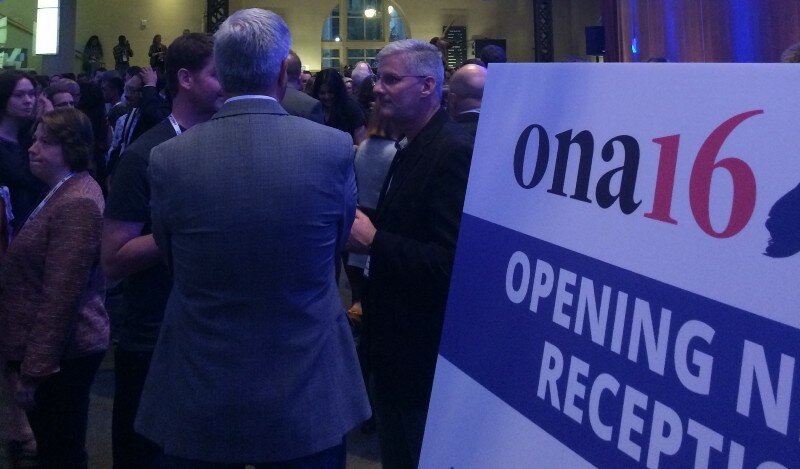From Sept. 15-17, 2016, journalists gathered in Denver, CO for the Online News Association (ONA)’s annual conference. One critique of the media industry was repeated over and over again: that journalists have lost a sense of connection with their audiences.
But newsrooms are trying to reestablish those connections, looking for more meaningful ways to engage with communities. That’s also what we’re trying to do at Discourse Media. We believe deep community engagement is essential to in-depth storytelling. Here is what we’re learning:
Creating value for specific communities
A basic assessment: many newsrooms have had “a bit of a lack of strategy”when it comes to connecting to communities, said Greg Barber, the director of digital news projects at the Washington Post. Barber also serves as head of strategy for the Coral Project.
But strategy is important when trying to get people engaged in journalism. It’s about knowing which audience you actually want to reach. It’s about finding out where that audience gathers on social media or in the real world — whether that means developing a beat around K-pop, like the Daily Dot did, or creating private groups on Facebook around special topics, like NPR and some others have done. And it’s about focusing on creating value for a specific community.
It's not just about tweets, FB posts & pageviews. It's about building an audience & finding where they already exist. —@AmyVernon #ONA16aud
— Stephanie L. Snyder (@slynnsnyder) September 17, 2016
New tools help to connect to communities
In Denver, Barber’s Coral Project launched one of the open-source tools they are developing. The software is built for newsrooms to crowdsource reporting. With the new tool, called Ask, journalists can ask readers to contribute stories or opinions. (Here is an audio of the full presentation.)
The idea behind the Coral Project’s tools is that journalists will need less time for surfacing good and meaningful input from users — and they might be able to create better connections to the communities they are serving.
Other tools like Hearken or GroundSource enable readers to ask questions of journalists. The Listening Post New Orleans uses GroundSource, a text messaging system for engaging communities, to ask questions like “How affordable is housing?” or “How healthy is your health insurance?”
For many newsrooms these tools could mean a major shift in reporting, because “as an industry, we are not very interested in what people have to say,” said Terry Parris Jr., engagement editor at ProPublica. New tools provide the chance to make reporting much more about people and their stories, and about researching a topic together with communities.
Hey journos! Print this out and stick it on your wall! (and follow @wearehearken and @LP_NOLA) #EIJ16 pic.twitter.com/e9oDePPHLM
— ? Flip Prior ? (@FlipPrior) September 18, 2016
Meaningful discussions away from social media
While some news organizations are abandoning comment sections on their sites, others are trying to make more out of discussions with their readers by moving them away from social media. The hope is that discussions might become more meaningful and less abusive, since social media isn’t always a safe space for discussions.
The Washington Post did this recently when they created a reader community focused on the gender pay gap in tech companies, using a channel on Slack. The goal was to foster conversations that were already happening. At the same time, the discussions provided inspiration for stories or even direct input for the Post’s reporting.
What can storytellers gain?
To really engage such a community, you have to commit for the long run. But that effort is worth it, said Monica Guzman. She’s studying community engagement as a 2016 Nieman Fellow and wrote a guide for engaging audiences.
(Guzman participated in an ONA session called “Designing Journalism for Conversation”. Here is a Google Doc with links to articles mentioned in the session.)
It’s easy to talk about these things in theory, but what does it look like in practice? ProPublica created a community of veterans and their relatives who had been exposed to Agent Orange. Through the community, the newsroom collected almost 6,000 stories as part of their research. With all this input, the newsroom produced in-depth reports about the issue.
(ProPublica also won an Online News Award for the research, together with The Virginian-Pilot newspaper.)
ProPublica reporter Parris Jr.’s simple advice: First research the community you’re reporting on, then reach out to the community, and then keep them engaged by actually replying to their comments, emails, and questions.
And how to keep a discussion alive? “Highlight strong contributions as models for others to follow,” said Guzman, and “make the conversations you spark around your work as valuable to their participants as possible.”
Allow the community to tell you what they know. @terryparrisjr #ONA16 #ONA16connect
— J. Staas Haught (@TheGoalieNet) September 15, 2016
In trying to work closer together with communities, there is a lot to gain for news organizations. Conversations with readers actually help build relationships, said Greg Barber. “People who comment and those who read comments are by far most loyal,” said Barber.
“People want to make your journalism better,” said Sydette Harry, community lead for the Coral Project. “And they want to do it together.”
Want to learn more from ONA16?
Lauren Katz from Vox.com has created a great Google spreadsheet with links to more material from the many sessions at the conference.
Revisit the discussions from ONA16 on Twitter about community engagement with these hashtags: #ona16connect, #ona16comments, #ona16aud.

